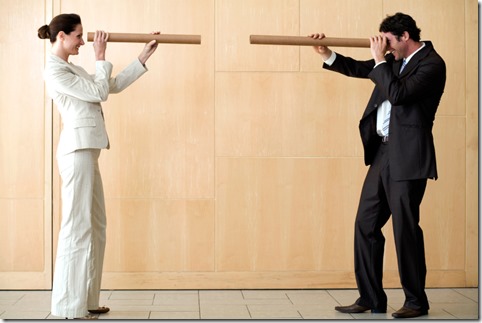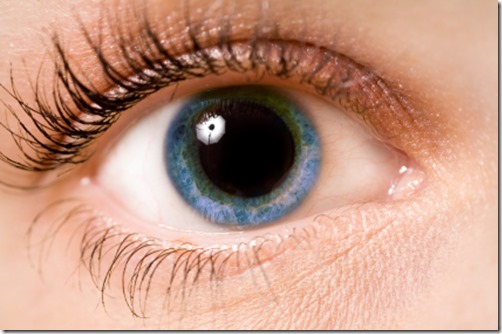Study: Does Eye Contact Hurt Your Ability To Persuade?
Every public speaking expert I know advises presenters to forge a connection with their audiences by maintaining steady eye contact.
RELATED: FOR HOW MANY SECONDS SHOULD YOU MAKE EYE CONTACT?
But a highly publicized study published in Psychological Science suggests that eye contact may actually make people “more resistant to persuasion, especially when they already disagree.”
“’There is a lot of cultural lore about the power of eye contact as an influence tool,’ says lead researcher Frances Chen, who conducted the studies at the University of Freiburg, Germany, and is now an assistant professor at the University of British Columbia. ‘But our findings show that direct eye contact makes skeptical listeners less likely to change their minds, not more, as previously believed,’ says Chen.
Is she right? And if so, what does it mean for public speakers?
According to the press release about the study, the researchers “…found that the more time participants spent looking at a speaker’s eyes while watching a video, the less persuaded they were by the speaker’s argument.”
Co-lead researcher Julia Minson of the Harvard Kennedy School of Government concluded that, “Whether you’re a politician or a parent, it might be helpful to keep in mind that trying to maintain eye contact may backfire if you’re trying to convince someone who has a different set of beliefs than you,”
But watching a video isn’t the same as being one member of an audience out of many with a live speaker, so I’m not sure the methodology used by the researchers is naturalistic enough to be applied broadly.
In the research, one viewer looked directly into the eyes of one speaker on a screen, presumably maintaining steady eye contact throughout. But what if that one viewer had been one member of a 50-member audience, during which the speaker gave that viewer a proportional amount of eye contact, meaning during just two percent of the presentation? Would that have the same impact on persuasion?
There appears to be a lot of conflicting data on this point. According to Nonverbal Communication in Human Interaction:
”Research shows that listeners judge speakers who gaze more as more persuasive, informed, truthful, sincere, and credible, and even pictured faces appear more trustworthy when the eyes are showing a direct versus an averted gaze (Wyland & Forgas, 2010). Also, compliance with a request can be enhanced if the requester engages in more gazing within an appropriate range (Gueguen & Jacob, 2002).”
I wouldn’t dismiss the research conducted by Chen and Minson. Perhaps it applies more to one-on-one communication than public speaking. But even then, it’s safe to assume that other factors they didn’t control for—age, gender, and height differences among live speakers, as well as each party’s role in the interaction (e.g. boss/employee, salesperson/prospective customer, two peers)—would also impact the effectiveness of any persuasion attempt.
This study is interesting, and it’s worth noting. But I wouldn’t advise speakers to change their approach in live presentations based on this research alone.
Note: I asked Dr. Chen to respond to this article, and she kindly sent the following response:
“Our findings are in fact in line with prior research — in the case where the listener was sympathetic to the speaker’s view (i.e., when the listener expressed agreement with the speaker’s position on a sociopolitical issue before watching the video of the speaker). In those cases, we found that more eye contact was associated with more receptiveness. This direction of effect is consistent with the other research you mentioned.
Our research specifically showed that eye contact could backfire (i.e. lead to less persuasion) in cases where the speaker and listener start out disagreeing about an issue. It’s in this case that we believe that too much eye contact may be perceived as threatening, or as an attempt to dominate.
I do agree with you that the effects of steady one-on-one gaze from a video may not be the same as more “diffuse” gaze from a live speaker to a large audience. We’re currently planning some follow-up studies to address exactly these questions!”
Want to learn more about public speaking? Check out our recommended reading list!





There are so many potential contributing factors and interdependent variables that I would be loathe to assign any absolute conclusions from this.
Watching someone on a video screen creates an unnatural distance between the participants… In normal conversation, we all tend to subconsciously adjust our interpersonal distance to a comfortable compromise for both parties.
People on video tend to look more fixedly at the camera lens, with fewer natural glances away to signal thought, memory, or contemplation. Blink rates can be unnatural as well. Was the speaker using a teleprompter, reciting a memorized speech, or speaking naturally? Did the researchers test different framing and focal distances for the speaker?
How did the type of content affect the viewers’ perception? I’ll bet the effect is different depending on whether the speaker is seen as empathetic, antagonistic, academic, or persuasive.
Maybe the full test description and data is more revealing, but I wouldn’t change any behavioral practices based on the short summary version!